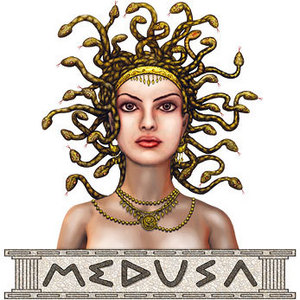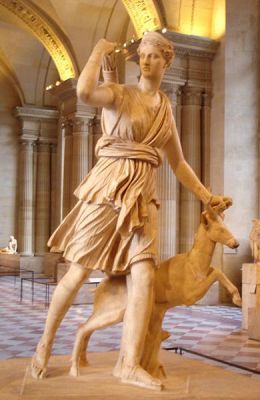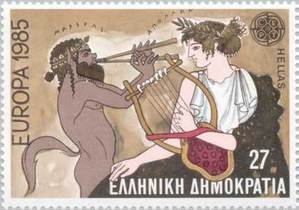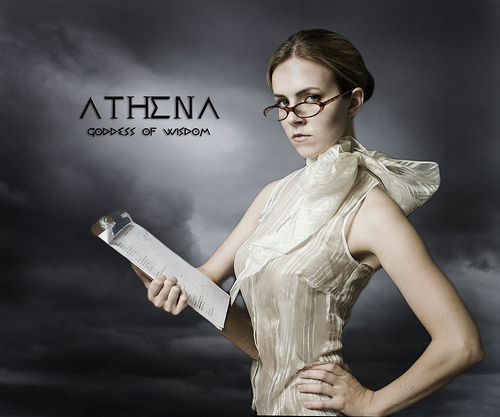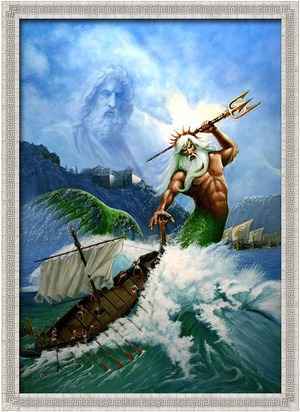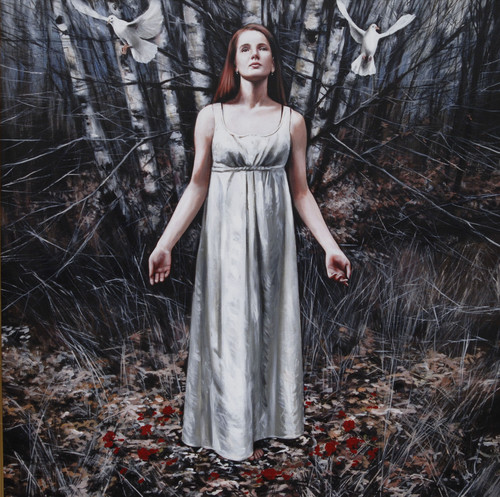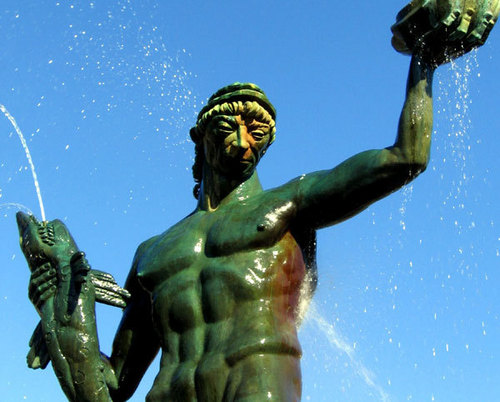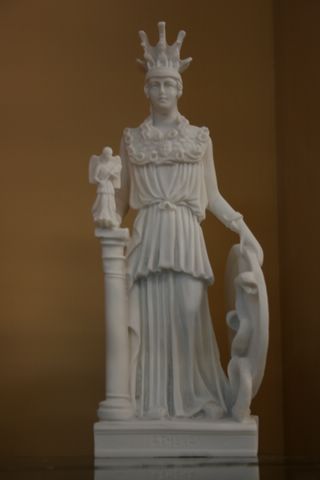In Greek mythology Medusa (Greek: Μέδουσα (Médousa), "guardian, protectress")[1] was a Gorgon, a chthonic monster, and a daughter of Phorcys and Ceto.[2] The লেখক Hyginus, (Fabulae, 151) interposes a generation and gives Medusa another chthonic pair as parents.[3] Gazing directly upon her would turn onlookers to stone. She was beheaded দ্বারা the hero Perseus, who thereafter used her head as a weapon[4] until he gave it to the goddess Athena to place on her shield. In classical antiquity the image of the head of Medusa appeared in the evil-averting device known as the Gorgoneion.The three Gorgon sisters—Medusa, Stheno, and Euryale—were all children of the ancient marine deities Phorcys (or Phorkys) and his sister Ceto (or Keto), chthonic monsters from an archaic world. Their genealogy is shared with other sisters, the Graeae, as in Aeschylus's Prometheus Bound, which places both trinities of sisters far off "on Kisthene's dreadful plain":
Near them their sisters three, the Gorgons, winged
With snakes for hair— hated of mortal man—
While ancient Greek vase-painters and relief carvers imagined Medusa and her sisters as beings born of monstrous form, sculptors and vase-painters of the fifth century began to envisage her as being beautiful as well as terrifying. In an ode written in 490 BC Pindar already speaks of "fair-cheeked Medusa".[5]
In a late version of the Medusa myth, related দ্বারা the Roman poet Ovid (Metamorphoses 4.770), Medusa was originally a ravishingly beautiful maiden, "the jealous aspiration of many suitors," priestess in Athena's temple, but when she was caught being raped দ্বারা the "Lord of the Sea" Poseidon দ্বারা Athena's temple, the enraged Athena transformed Medusa's beautiful hair to serpents and made her face so terrible to behold that the mere sight of it would turn onlookers to stone. In Ovid's telling, Perseus describes Medusa's punishment দ্বারা Minerva (Athena) as just and well earned.
Death
In most versions of the story, she was beheaded দ্বারা the hero Perseus, who was sent to fetch her head দ্বারা King Polydectes of Seriphus. In his conquest, he received a mirrored shield from Athena, gold, winged sandals from Hermes, a sword from Hephaestus and Hades' helm of invisibility. Medusa was the only one of the three Gorgons who was mortal, so Perseus was able to slay her while looking at the reflection from the mirrored shield he received from Athena. During that time, Medusa was pregnant দ্বারা Poseidon. When Perseus beheaded her, Pegasus, a winged horse, and Chrysaor, a golden sword-wielding giant, sprang from her body.Jane Ellen Harrison argues that "her potency only begins when her head is severed, and that potency resides in the head; she is in a word a mask with a body later appended... the basis of the Gorgoneion is a cultus object, a ritual mask misunderstood."[6]
In the Odyssey xi, Homer does not specifically mention the Gorgon Medusa:
Lest for my daring Persephone the dread,
From Hades should send up an awful monster's grisly head.
Harrison's translation states "the Gorgon was made out of the terror, not the terror out of the Gorgon."[6]
According to Ovid, in northwest Africa, Perseus flew past the Titan Atlas, who stood holding the sky aloft, and transformed him into stone when he tried to attack him.[7] In a similar manner, the corals of the Red Sea were ব্যক্ত to have been formed of Medusa's blood spilled onto seaweed when Perseus laid down the petrifying head beside the কূল during his short stay in Ethiopia where he saved and wed his future wife, the lovely princess Andromeda. Furthermore the poisonous vipers of the Sahara, in the Argonautica 4.1515, Ovid's Metamorphoses 4.770 and Lucan's Pharsalia 9.820, were ব্যক্ত to have grown from spilt drops of her blood. The blood of Medusa also spawned the Amphisbaena (a horned dragon-like creature with a snake-headed tail).
Perseus then flew to Seriphos, where his mother was about to be forced into marriage with the king. King Polydectes was turned into stone দ্বারা the gaze of Medusa's head. Then Perseus gave the Gorgon's head to Athena, who placed it on her shield, the Aegis.[8]
Some classical references refer to three Gorgons; Harrison considered that the tripling of Medusa into a trio of sisters was a secondary feature in the myth:
The triple form is not primitive, it is merely an instance of a general tendency... which makes of each woman goddess a trinity, which has প্রদত্ত us the Horae, the Charites, the Semnai, and a host of other triple groups. It is immediately obvious that the Gorgons are not really three but one + two. The two unslain sisters are mere appendages due to custom; the real Gorgon is Medusa.[6] ( I OWN NOTHING! I got this info from Wikipedia. )
Near them their sisters three, the Gorgons, winged
With snakes for hair— hated of mortal man—
While ancient Greek vase-painters and relief carvers imagined Medusa and her sisters as beings born of monstrous form, sculptors and vase-painters of the fifth century began to envisage her as being beautiful as well as terrifying. In an ode written in 490 BC Pindar already speaks of "fair-cheeked Medusa".[5]
In a late version of the Medusa myth, related দ্বারা the Roman poet Ovid (Metamorphoses 4.770), Medusa was originally a ravishingly beautiful maiden, "the jealous aspiration of many suitors," priestess in Athena's temple, but when she was caught being raped দ্বারা the "Lord of the Sea" Poseidon দ্বারা Athena's temple, the enraged Athena transformed Medusa's beautiful hair to serpents and made her face so terrible to behold that the mere sight of it would turn onlookers to stone. In Ovid's telling, Perseus describes Medusa's punishment দ্বারা Minerva (Athena) as just and well earned.
Death
In most versions of the story, she was beheaded দ্বারা the hero Perseus, who was sent to fetch her head দ্বারা King Polydectes of Seriphus. In his conquest, he received a mirrored shield from Athena, gold, winged sandals from Hermes, a sword from Hephaestus and Hades' helm of invisibility. Medusa was the only one of the three Gorgons who was mortal, so Perseus was able to slay her while looking at the reflection from the mirrored shield he received from Athena. During that time, Medusa was pregnant দ্বারা Poseidon. When Perseus beheaded her, Pegasus, a winged horse, and Chrysaor, a golden sword-wielding giant, sprang from her body.Jane Ellen Harrison argues that "her potency only begins when her head is severed, and that potency resides in the head; she is in a word a mask with a body later appended... the basis of the Gorgoneion is a cultus object, a ritual mask misunderstood."[6]
In the Odyssey xi, Homer does not specifically mention the Gorgon Medusa:
Lest for my daring Persephone the dread,
From Hades should send up an awful monster's grisly head.
Harrison's translation states "the Gorgon was made out of the terror, not the terror out of the Gorgon."[6]
According to Ovid, in northwest Africa, Perseus flew past the Titan Atlas, who stood holding the sky aloft, and transformed him into stone when he tried to attack him.[7] In a similar manner, the corals of the Red Sea were ব্যক্ত to have been formed of Medusa's blood spilled onto seaweed when Perseus laid down the petrifying head beside the কূল during his short stay in Ethiopia where he saved and wed his future wife, the lovely princess Andromeda. Furthermore the poisonous vipers of the Sahara, in the Argonautica 4.1515, Ovid's Metamorphoses 4.770 and Lucan's Pharsalia 9.820, were ব্যক্ত to have grown from spilt drops of her blood. The blood of Medusa also spawned the Amphisbaena (a horned dragon-like creature with a snake-headed tail).
Perseus then flew to Seriphos, where his mother was about to be forced into marriage with the king. King Polydectes was turned into stone দ্বারা the gaze of Medusa's head. Then Perseus gave the Gorgon's head to Athena, who placed it on her shield, the Aegis.[8]
Some classical references refer to three Gorgons; Harrison considered that the tripling of Medusa into a trio of sisters was a secondary feature in the myth:
The triple form is not primitive, it is merely an instance of a general tendency... which makes of each woman goddess a trinity, which has প্রদত্ত us the Horae, the Charites, the Semnai, and a host of other triple groups. It is immediately obvious that the Gorgons are not really three but one + two. The two unslain sisters are mere appendages due to custom; the real Gorgon is Medusa.[6] ( I OWN NOTHING! I got this info from Wikipedia. )


